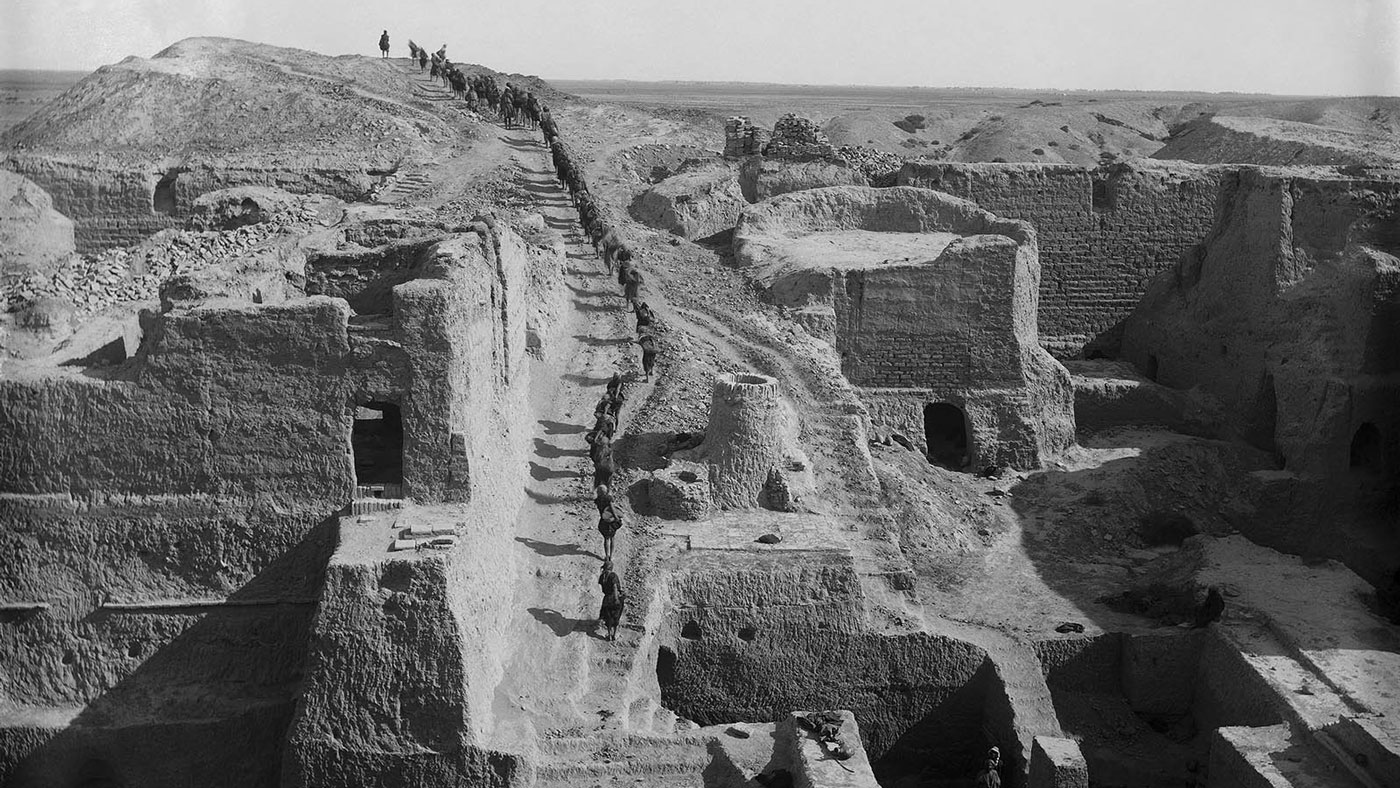Ur, Iraq

Located in southern Iraq, near the former northern limits of the Persian Gulf, Ur was one of the most famous archaeological excavations—along with Tutankhamun’s tomb in Egypt—during the early 20th century. Frequently described in the popular press, the work at Ur brought the magic of archaeology to life, particularly by tying the discoveries into familiar biblical stories. Between 1922 and 1934, the Joint Expedition of the British Museum and the Penn Museum was directed by C. Leonard Woolley and uncovered some of the most well-known and celebrated art from ancient Mesopotamia. These finds were divided between the two partner institutions (25% each) and the Baghdad Museum in Iraq (50%).
- Object[584]
- no[584]
- no[584]
- near eastern[584]
- amulet[5]
- arrowhead[29]
- arrowheads[1]
- awl[1]
- axe[2]
- ball[2]
- balls[2]
- bead[9]
- bead spacer[1]
- beads[1]
- blade[56]
- blade fragments[2]
- bone fragment[1]
- bottle[1]
- bowl[12]
- brick[1]
- bronze fragment[1]
- bulla[1]
- cast[2]
- celt[24]
- chalice[1]
- cockle shell[1]
- comb (hair - grooming tool)[5]
- core[1]
- cornice[1]
- cosmetic container[1]
- cosmetic shell[48]
- cosmetic shell fragment[1]
- cup[1]
- diadem[1]
- disk[1]
- door socket[2]
- drill[1]
- duck weight[1]
- earring[2]
- eye bead[1]
- figurine[1]
- finger ring[1]
- flint and steel case[1]
- game board[1]
- garment pin[1]
- grinder[21]
- hair pin[4]
- hairring[2]
- hammer[3]
- hand axe[4]
- handle[2]
- holder[1]
- horse gear[2]
- human statuette[2]
- implement[2]
- inlay[25]
- jar[3]
- jewelry[3]
- knife handle[1]
- lamp[7]
- lid[1]
- lithic[2]
- macehead[6]
- metal fragment[1]
- nail[8]
- nails[1]
- needle[2]
- object[18]
- ornament[7]
- pegs[1]
- pendant[1]
- pick[2]
- pigment[5]
- pin[3]
- polisher[5]
- pot[2]
- raw material[8]
- razor blade[5]
- rein ring[2]
- reproduction[9]
- ring[2]
- sample[3]
- scraper[16]
- seal impression[6]
- sealing[3]
- shell fragments[3]
- sherd[2]
- spearhead[2]
- spindle whorl[14]
- statue[2]
- statue fragment[2]
- statuette[2]
- stone[7]
- stone fragment[7]
- string of beads[2]
- stud[2]
- toilet kit[5]
- token[2]
- ur-namu stele[61]
- vase[2]
- vessel[2]
- weight[20]
- weights[3]
- whetstone[23]
- agade[1]
- al 'ubaid[1]
- early dynastic i[1]
- early dynastic iii[3]
- jemdet nasr[3]
- kassite[2]
- middle babylonian period[1]
- neo-babylonian[1]
- pre-flood[1]
- prehistoric[1]
- ur i[1]
- ur iii[4]
- -3 metres below surface; pg[1]
- a.h. house ii, main court below pavement ii[1]
- a.h. house iii[1]
- b.c dungi, room 12[1]
- b.c. dungi room 10[1]
- diqdiqqeh[12]
- found 6 to 7 m. below brick pavement dated ca. 3100 b.c. in the prehistorical settlement. level of the pre flood period. pg. n.w.[1]
- in filling below temenos wall on sire of sulgi tomb[1]
- kassite level ii, a.h.[1]
- near pg 1068, loose in soil.[1]
- outside of g. 56 n.h.[1]
- pg 1157/3[1]
- pg 1195[1]
- pg 1237/67[1]
- pg 1237/70[2]
- pg 1749[1]
- pg 580 ?[1]
- pg 59 c.l.w.[1]
- pg 789[2]
- pg 800[2]
- pg. 1490[1]
- preflood and low lying strata[1]
- room i, house 3, a.h.[1]
- rubbish a.h.[1]
- rubbish over pg[1]
- t. 0097[1]
- ziggurat n.w. 31, deep level[1]
- agate[2]
- alabaster[8]
- basalt[16]
- bitumen[1]
- bone[15]
- bronze[8]
- carnelian[5]
- ceramic[8]
- chalcedony[1]
- clay[7]
- cockle shell[2]
- conch shell[4]
- copper[6]
- copper alloy[2]
- diorite[29]
- dolorite[1]
- electrotype[10]
- electrum[1]
- flint[75]
- frit[1]
- glass[3]
- gold[5]
- gypsum[2]
- hematite[2]
- ivory[6]
- jadeite[1]
- jasper[5]
- lapis lazuli[9]
- limestone[35]
- magnesite[1]
- marble (stone)[6]
- metal[2]
- mollusk shell[1]
- mud[1]
- obsidian[42]
- paint[2]
- pigment[46]
- plaster[7]
- plaster of paris[1]
- porphyry[4]
- quartz[1]
- sand[3]
- sandstone[15]
- serpentine[2]
- shell[70]
- silver[7]
- soapstone[6]
- steatite[8]
- stone[137]
- terracotta[5]
- wood[1]
- actual citation[69]
1 - 30 of 584 Records
1 - 30 of 584 Records


